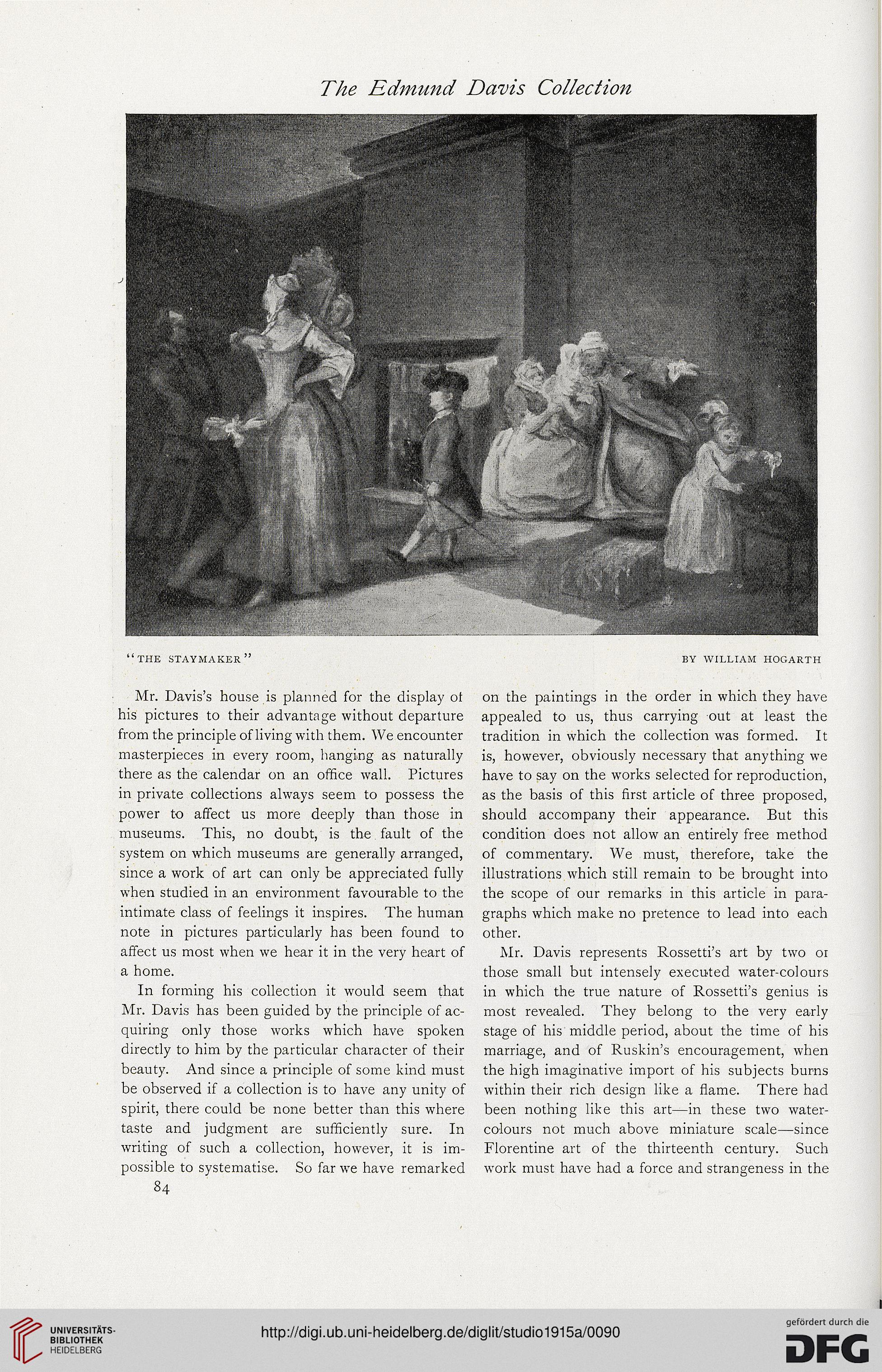The Edmund Davis Collection
“THE STAYMAKER”
Mr. Davis’s house is planned for the display of
his pictures to their advantage without departure
from the principle of living with them. We encounter
masterpieces in every room, hanging as naturally
there as the calendar on an office wall. Pictures
in private collections always seem to possess the
power to affect us more deeply than those in
museums. This, no doubt, is the fault of the
system on which museums are generally arranged,
since a work of art can only be appreciated fully
when studied in an environment favourable to the
intimate class of feelings it inspires. The human
note in pictures particularly has been found to
affect us most when we hear it in the very heart of
a home.
In forming his collection it would seem that
Mr. Davis has been guided by the principle of ac-
quiring only those works which have spoken
directly to him by the particular character of their
beauty. And since a principle of some kind must
be observed if a collection is to have any unity of
spirit, there could be none better than this where
taste and judgment are sufficiently sure. In
writing of such a collection, however, it is im-
possible to systematise. So far we have remarked
84
BY WILLIAM HOGARTH
on the paintings in the order in which they have
appealed to us, thus carrying out at least the
tradition in which the collection was formed. It
is, however, obviously necessary that anything we
have to say on the works selected for reproduction,
as the basis of this first article of three proposed,
should accompany their appearance. But this
condition does not allow an entirely free method
of commentary. We must, therefore, take the
illustrations which still remain to be brought into
the scope of our remarks in this article in para-
graphs which make no pretence to lead into each
other.
Mr. Davis represents Rossetti’s art by two 01
those small but intensely executed water-colours
in which the true nature of Rossetti’s genius is
most revealed. They belong to the very early
stage of his middle period, about the time of his
marriage, and of Ruskin’s encouragement, when
the high imaginative import of his subjects burns
within their rich design like a flame. There had
been nothing like this art—in these two water-
colours not much above miniature scale—since
Florentine art of the thirteenth century. Such
work must have had a force and strangeness in the
“THE STAYMAKER”
Mr. Davis’s house is planned for the display of
his pictures to their advantage without departure
from the principle of living with them. We encounter
masterpieces in every room, hanging as naturally
there as the calendar on an office wall. Pictures
in private collections always seem to possess the
power to affect us more deeply than those in
museums. This, no doubt, is the fault of the
system on which museums are generally arranged,
since a work of art can only be appreciated fully
when studied in an environment favourable to the
intimate class of feelings it inspires. The human
note in pictures particularly has been found to
affect us most when we hear it in the very heart of
a home.
In forming his collection it would seem that
Mr. Davis has been guided by the principle of ac-
quiring only those works which have spoken
directly to him by the particular character of their
beauty. And since a principle of some kind must
be observed if a collection is to have any unity of
spirit, there could be none better than this where
taste and judgment are sufficiently sure. In
writing of such a collection, however, it is im-
possible to systematise. So far we have remarked
84
BY WILLIAM HOGARTH
on the paintings in the order in which they have
appealed to us, thus carrying out at least the
tradition in which the collection was formed. It
is, however, obviously necessary that anything we
have to say on the works selected for reproduction,
as the basis of this first article of three proposed,
should accompany their appearance. But this
condition does not allow an entirely free method
of commentary. We must, therefore, take the
illustrations which still remain to be brought into
the scope of our remarks in this article in para-
graphs which make no pretence to lead into each
other.
Mr. Davis represents Rossetti’s art by two 01
those small but intensely executed water-colours
in which the true nature of Rossetti’s genius is
most revealed. They belong to the very early
stage of his middle period, about the time of his
marriage, and of Ruskin’s encouragement, when
the high imaginative import of his subjects burns
within their rich design like a flame. There had
been nothing like this art—in these two water-
colours not much above miniature scale—since
Florentine art of the thirteenth century. Such
work must have had a force and strangeness in the




